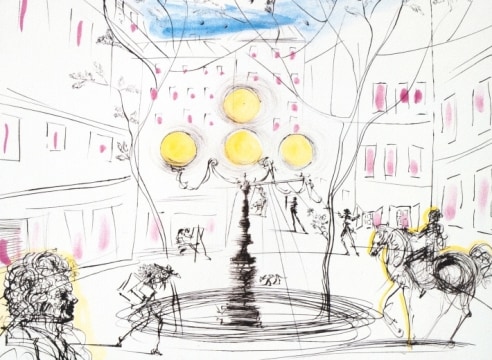
Singapore’s REDSEA Gallery presents for the first time in Asia DALI: The Pierre Argillet Collection, an exhibition of works by Surrealist master, Salvador Dali.
Originating from the renowned Pierre Argillet Collection, the exhibition of over 100 works including etchings, drawings, and tapestries will be on for viewing and acquisition at REDSEA Gallery from 22 March to 20 April 2014. All works from the Pierre Argillet Collection have been authenticated and signed by Salvador Dali and have never before left the Collection. The exhibition offers a rare glimpse into the friendship between Dali and his publisher, Pierre Argillet, inspiring a body of work that dealt with both western and eastern themes.
Dali & Argillet
To introduce the Collection in Singapore will be Pierre Argillet’s daughter, Christine Argillet. Having spent much of her childhood in the presence of Salvador Dali, Ms Argillet offers first-hand accounts and personal insights into the collaboration between her father and Salvador Dali and the works they produced together.
“This presentation is a tribute to the work of my father, Pierre Argillet, as an extraordinary publisher of the Dada and Surrealist group. This collection reflects his constant endeavour and his close collaboration with the artists of these two movements, especially Salvador Dali. My goal is to have this collection presented in the finest galleries and museums throughout the world,” says Ms Christine Argillet about the collection to be exhibited in Singapore.
Pierre Argillet was an avid collector of Futurist, Dadaist and Surrealist works and had, from very early on, met with the major artists of the 20th century. But it was with Salvador Dali that a long and fruitful collaboration developed. Together as artist and publisher, Dali and Argillet produced nearly 200 etchings over a period that stretched 30 years. In 1974, they parted company, as Pierre Argillet did not want to go along with Dali’s desire to make photo-based lithographs. For Argillet, only traditional copper etchings were acceptable. They remained friends until Dali’s death in 1989.
Highlights of the Exhibition
The exhibition will feature 112 pieces of Dali’s original etchings, drawings, and tapestries.
“We are extremely privileged to present for the first time in Asia, the original works of Salvador Dali from the prestigious Pierre Argillet collection. These etchings, drawings and tapestries have been part of the family collection since their creation by Dali during his collaborative years with Pierre Argillet. The exhibition, Salvador Dali: The Pierre Argillet Collection, thus offers the rare opportunity to view and acquire works of impeccable provenance by the Surrealist master,” says Mr Chris Churcher, Founder & Director, REDSEA Gallery.
Among the highlights of the exhibition is the series Les Chants de Maldoror. Dali was originally commissioned by publisher Albert Skira in 1934 to produce 44 heliogravures to illustrate the book, Les Chants de Maldoror, a literary work by French writer Lautreamont considered to be a major source of inspiration for artists of the Surrealist Movement. In 1971, Pierre Argillet purchased 42 original plates from Baron Petiet in Paris. Following the purchase, Dali decided to rework eight of the plates, adding an elaborated vision of his traumas from childhood to the work. Under the terms of an agreement signed in 1973 by Salvador Dali, Pierre Argillet and Albert Skira, it was agreed that 50 prints were to be published, together with the 100 even-numbered books not published in 1934. The exhibition will showcase the suite of 50 prints that comprise the series Les Chansons de Maldoror.
Other highlights include two series in the exhibition that linked Dali to Asia - Poems of Mao Zedong and The Hippies. In 1967, in the midst of the Cultural Revolution, Pierre Argillet commissioned Dali to illustrate the poems by Mao Zedong. Dali created eight illustrations in a series called Poems of Mao Zedong, some of which were political satires, executed in Dali’s surrealist vision. Among them is Portrait of Mao, featuring a headless figure in a Mao suit. To Argillet’s question on why the figure was headless, Dali had replied, “Well, the man is so tall that he didn’t fit on the page!” All eight etchings reworked in drypoint from the Poems of Mao Zedong will be on exhibit at the gallery.
In 1969 Pierre Argillet took his young daughter to visit India where he took many photographs of the new world surrounding them. Upon his return, he excitedly shared these strange and beautiful photographs with Dali, suggesting that he capture this moment in time. The resulting 11 drypoint hand-coloured etchings form the series, The Hippies, and reveal the superb, spontaneous and consummate technique of the artist at the peak of his maturity. Outlandish free flowing surrealist characters or situations appear through intricate whirls or golden halos. The Hippies was for Dali an important series that linked eastern and western cultures.
Inspired by Pablo Picasso’s Tauromachie, the etchings from Dali’s series, Surrealistic Bullfight, epitomise his style with their burlesque touches. He reinterprets his fellow Catalonian by overlaying the subject of the bullfight with his macabre yet humorous vision. Comprising seven original etchings, this series produced in 1967 revisits a popular Catalan theme in true Dali fashion.
Drawing closely on the symbolism of ancient Greek legends, Dali worked on the series Mythologies. Using what he called ‘hasard objectif’ (the meaningful manifestation of chance), he would often start with an abstract smudge, created in a single motion and continued to develop his theme from this sign of fate. This is particularly noticeable in his etchings entitled OEdipus and Sphinx, Theseus and Minotaurus, Jupiter, Pegasus, and The Milky Way. When Dali worked on these plates, he experimented with all kinds of unusual tools like chisels, nails or wheels for the Birth of Venus, and even a real octopus immersed in acid, which left its imprint on his Medusa. The 16 mixed media prints were published between 1963 and 1965.


